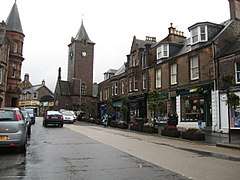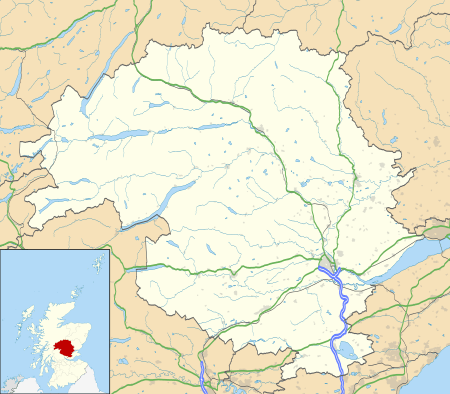Crieff
Crieff (/kriːf/ (![]()
Crieff
| |
|---|---|
 High Street, Crieff | |
 Crieff Location within Perth and Kinross | |
| Population | 7,368 [1] |
| OS grid reference | NN863219 |
| • Edinburgh | 38 mi (61 km) |
| • London | 368 mi (592 km) |
| Council area | |
| Lieutenancy area | |
| Country | Scotland |
| Sovereign state | United Kingdom |
| Post town | CRIEFF |
| Postcode district | PH7 |
| Dialling code | 01764 |
| Police | Scotland |
| Fire | Scottish |
| Ambulance | Scottish |
| UK Parliament | |
| Scottish Parliament | |
History
For a number of centuries Highlanders came south to Crieff to sell their black cattle, whose meat and hides were avidly sought by the growing urban populations in Lowland Scotland and the north of England. The town acted as a gathering point for the Michaelmas cattle sale held each year, when the surrounding fields and hillsides would be black with the tens of thousands of cattle, some from as far away as Caithness and the Outer Hebrides. (In 1790 the population of Crieff was about 1,200, which gave a ratio of ten cows per person.)
During the October Tryst (as the cattle gathering was known), Crieff was a prototype "wild west" town. Milling with the cattle were horse thieves, bandits and drunken drovers. The inevitable killings were punished on the Kind Gallows, for which Crieff became known throughout Europe.
By the 18th century the original hanging tree used by the Earls of Strathearn had been replaced by a formal wooden structure in an area called Gallowhaugh – now Gallowhill, at the bottom of Burrell Street. What is now Ford Road was Gallowford Road which led down past the gallows to the crossing point over the River Earn. In such a prominent position, Highlanders passing along the principal route would see hanged bodies dangling overhead, prompting from them the words, "God bless you, and the Devil damn you." Lord Macaulay's history talks of a score of plaids hanging in a row, but the remains of the Gallows – held in Perth Museum – suggest the maximum capacity was only six. Crieff's parish church kept a strong Episcopalian dominance from the Reformation in 1560 until the Revolution of 1688. In 1682 William Murray ignored the Presbytery and brought Episcopalian format into worship, including the Lord's Prayer and the Doxology. The Apostles' Creed was also used at baptisms. After the Jacobite victory at Killiecrankie, Murray quoted the 118th Psalm: "This is the day God made, in it we'll joy triumphantly".
Rob Roy MacGregor visited Crieff on many occasions, often to sell cattle. Rob Roy's outlaw son was pursued through the streets of Crieff by soldiers and killed. In the second week of October 1714 the Highlanders gathered in Crieff for the October Tryst. By day Crieff was full of soldiers and government spies. Just after midnight, Rob Roy and his men marched to Crieff Town Square and rang the town bell. In front of the gathering crowd they sang Jacobite songs and drank a good many loyal toasts to their uncrowned King James VIII.
In 1716, 350 Highlanders returning from the Battle of Sheriffmuir burned most of Crieff to the ground. In 1731, James Drummond, 3rd Duke of Perth, laid out the town's central James Square and established a textile industry with a flax factory. In the 1745 rising the Highlanders were itching to fire the town again and were reported as saying "she shoud be a braw toun gin she haed anither sing". But it was saved by the Duke of Perth – a friend and supporter of Prince Charles. In February 1746 the Jacobite army was quartered in and around the town with Prince Charles Edward Stuart holding his final war council in the old Drummond Arms Inn in James Square – located behind the present abandoned hotel building in Hill Street. He also had his horse shod at the blacksmith's in King Street. Later in the month he reviewed his troops in front of Ferntower House, on what is today the Crieff Golf Course.
In the 19th century, Crieff became a fashionable destination for tourists visiting the Highlands and a country retreat for wealthy businessmen from Edinburgh, Glasgow and beyond. Many such visitors attended the Crieff hydropathic establishment, now the Crieff Hydro, which opened in 1868.[2] Crieff still functions as a tourist centre. The large villas stand as testaments to its use by wealthy city-dwellers.
Crieff was once served by Crieff railway station, which linked the town to Perth, Comrie and Gleneagles.[3] The station was opened in 1856 by the Crieff Junction Railway, but closed in 1964 by British Railways as one of the Beeching cuts.
Fame in verse
Crieff was praised by the poetaster William McGonagall in "Crieff".
"Ye lovers of the picturesque, if ye wish to drown your grief,
Take my advice, and visit the ancient town of Crieff."[4]
Events
Every year the town hosts the Crieff Highland Games, which include music and dancing competitions and feats of strength.
Schools
- Morrison's Academy
- Ardvreck School
- St Dominics RC Primary School
- Crieff Primary School – A historic picture of Crieff Primary School, see The Schoolmaster,[5] (1953) black and white, 19 minutes. The schoolmaster is played by Walter Carr and the film is narrated by Gordon Jackson.
- Strathearn Community Campus
Notable people
- Dallas Anderson (1874–1934), actor[6]
- John Terence Coppock (1921–2000), geographer
- John Craig (1896–1970), recipient of the Victoria Cross
- Daniel John Cunningham (1850–1909), anatomist and author[7]
- Very Rev John Cunningham (1819–1893) father of the above, Moderator of the General Assembly of the Church of Scotland in 1886
- Jackie Dewar (1923–2011), footballer
- Eve Graham (born 1943), former singer with New Seekers, has lived in Crieff since 2004[8]
- David Jacks, first commercial producer of Monterey Jack cheese
- Denis Lawson (born 1947), actor[9][10]
- Saul Marron (born 1981), actor
- Ewan McGregor (born 1971), actor[11]
- Alexander Murray (1810–1884), geologist
- Neil Paterson (1915–1995), Oscar-winning screenwriter, was a resident of Crieff until his death.[12][13]
- Fiona Pennie (born 1982), Olympic canoeist[14]
- William Reid (VC) (1921–2001) recipient of the Victoria Cross
- Brian Stewart (1922–2015), soldier, diplomat and spy
- Rory Stewart (born 1973), politician[15][16]
- Sophie Stewart (1908–1977), actor
- Gavin Strang (born 1943), politician[17]
- Sheila Stuart (1892–1974), children's writer, died here in 1974
- Simon Taylor (born 1979), Scottish international rugby player[18][19]
- D. P. Thomson (1896–1974), evangelist of the Church of Scotland, Warden of the St Ninian's Centre[20]
- Thomas Thomson (1773–1852), chemist[21]
References
- "Scotland's Census 2011 - Crieff Locality Area Profile". www.scotlandscensus.gov.uk. 2011. Retrieved 27 November 2015.
- Bradley, James; Dupree, Mageurite; Durie, Alastair (1997), "Taking the Water Cure: The Hydropathic Movement in Scotland, 1840–1940" (PDF), Business and Economic History, 26 (2): 426–437, retrieved 17 November 2009
- Railscot Retrieved 29 July 2018.
- McGonagall, William (1899). "Beautiful Crieff". McGonagall Online.
- Nairn, James S. "The Schoolmaster Day". Moving Image Archive. Anglo Scottish Pictures. Retrieved 24 November 2019.
- British Film Institute access date 19 January 2018.
- Kaufman, MH (February 2008). "Daniel John Cunningham (1850-1909): anatomist and textbook author, whose sons achieved distinction in the Army, Navy and Indian Medical Service". Journal of Medical Biography. 16 (1): 30–5. doi:10.1258/jmb.2006.006058. PMID 18463062.
- "New Seekers star Eve Graham looks back 40 years after their greatest hit". Daily Record. 12 March 2011. Retrieved 26 October 2012.
- Duke, Lynn (19 October 2012). "Denis attributes acting career to his Crieff roots". Daily Record.
- Carr, Ellie (19 May 2001). "He is the actor formerly known as Denis Lawson. Now he's more famous as Ewan McGregor's uncle. But he's not bitter". Herald Scotland. Retrieved 26 October 2012.
- Barratt, Nick (11 November 2006). "Family Detective". Daily Telegraph. Retrieved 26 October 2012.
- Moncur, James (6 March 2010). "Incredible story of the Dundee United footballer who won an Academy Award". Daily Record. Retrieved 26 October 2012.
- Rae, Douglas (16 June 1995). "OBITUARY: Neil Paterson". The Independent. Retrieved 26 October 2012.
- "Perthshire's sports awards nominees named". Perthshire Advertiser. 23 March 2012. Retrieved 26 October 2012.
- van Praagh, Anna (1 November 2009). "Rory Stewart: A new kind of Tory". Daily Telegraph. Retrieved 26 October 2012.
- Gossip, Shona (24 May 2010). "Article - Former Black Watch soldier shares his experiences". Press and Journal. Retrieved 26 October 2012.
- MP for Edinburgh East constituency, first elected in 1970, then re-elected in February 1974, October 1974, 1979, 1983, 1987, 1992, 1997, 2001 and 2005. He held several ministerial posts during his political career.
- "Restaurant review: Hawke & Hunter, Edinburgh". The Scotsman. 26 June 2009. Retrieved 26 October 2012.
- Purnell, Gareth (8 March 2008). "Simon Taylor: Sinatra of Scottish rugby hopes his latest return is a happy one". The Independent. Retrieved 26 October 2012.
- Bardgett, Frank (2010). Scotland's Evangelist - D.P. Thomson. Haddington: Handsel Press. pp. 253–258, 339–350. ISBN 978-1-871828-71-9.
- "Thomas Thomson". Electricscotland.com. Retrieved 26 October 2012.
External links

- Crieff Visitor Centre
- National Library of Scotland: SCOTTISH SCREEN ARCHIVE (selection of archive films about Crieff)